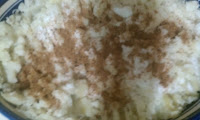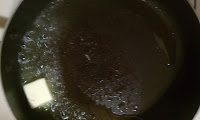Hello Foodies!
Today I am going to share one of my favorite snack recipes
with you. Dabeli!
It is a very popular street food of Gujarat and Mumbai. You
can find Dabeli stalls almost in every city of Gujarat and in Mumbai as (Kutchi
Dabeli). Everyone loves Dabeli. If it’s a 5 year child or a 50 year adult.
People have it at anytime of the day.
The most wonderful part of this dish is it has all
interesting ingredient. World most unique vegetable potato, fruits like
pomegranate pearls and grapes, crunchy masala peanuts and salty nylon or thin
Sev. Also it is served in a split bun called Pav in India. It’s delicious and
filling. It is made with a perfect blend or spice, salt, sweet and tangy
flavors all at a time.
We love Dabeli in my family and I am sure once you try this
yummy recipe and taste it you will also fall for it;)
Dabeli
Serving: 5-6 People
(Serving per person 2)
Preparation time: 15mins
Cook Time: 15 mins
Ingredients for Dabeli Masala
5 medium peeled &
boiled Potatoes
1 large onion finely
chopped
2 large or 4 medium
red tomatoes
3 tbsp. Dabeli Masala
powder
1 tbsp. oil
1 tbsp. butter
2 tbsp. or little more
sugar (as per taste)
1 tsp. red chilly
powder
3 tsp. lemon juice
1/4 cup of water
Salt to taste
Ingredients for Stuffing and Garnish:
10 hamburger buns (Pav) or
regular half cut buns (Pav)
1-cup masala peanuts
(Moongphali) or spicy peanuts
1/2 cup grated coconut (optional)
1-cup fresh pomegranate
pearls
1 tbsp. fresh pomegranate
pearls
1-cup red, green or black
grapes chopped in half
1 cup thin Nylon Sev
for Dabeli spread
1/2 cup thin Nylon Sev for
garnish while serving Dabeli
1/2 cup of date-tamarind
chutney / sauce
1/4 cup of spicy red
chilly garlic chutney
1/2 cup of finely chopped
coriander
1/2 cup finely chopped
onions to serve on top
Method:
As mentioned for
ingredients wash, boil & peel 5 medium potatoes. Then smash / crush them
fine with potato crusher. Add salt, sugar, red chilly powder & 2 tbsp. of
Dabeli masala powder to it.

Now in a nonstick pan heat
oil and butter. Once heated add onions to it and cook them till they get
translucent, changes the color & start releasing the oil. Now add finely
chopped tomatoes and cook them till they get soft and diluted into liquid or gravy
form. Now add 1tbsp. of Dabeli masala powder and pinch of salt to the gravy and
cook for 30 seconds or minute. As you see the oil starts releasing from the
gravy add the masala mixed smashed potato mixture to it. Then add 1/4 cup water
and stir it upside down. Now add lemon juice and stir it upside down till you
see the masala is well blended in the mixture. and the texture of masala gets
smooth or easy to spread even.


Now spread the mixture in
the plate or blow evenly. Garnish it with chopped onions, pomegranate pearls,
chopped grapes, nylon Sev and coriander leaves evenly on the spread as shown in
pictures.


Take a flat pan and heat
it warm the hamburger buns with spreading little butter on topside of the buns.
Now split or open the bun in half and spread red chilly and garlic chutney on
both the side. Then spread sweet date tamarind chutney on each side and press
the Dabeli spread on bottom side of bun. Garnish it with onions, pomegranate
and Sev in a very little portion. Close the bun and serve it.



You can also serve it with date tamarind chutney and chilly garlic chutney on side.














































